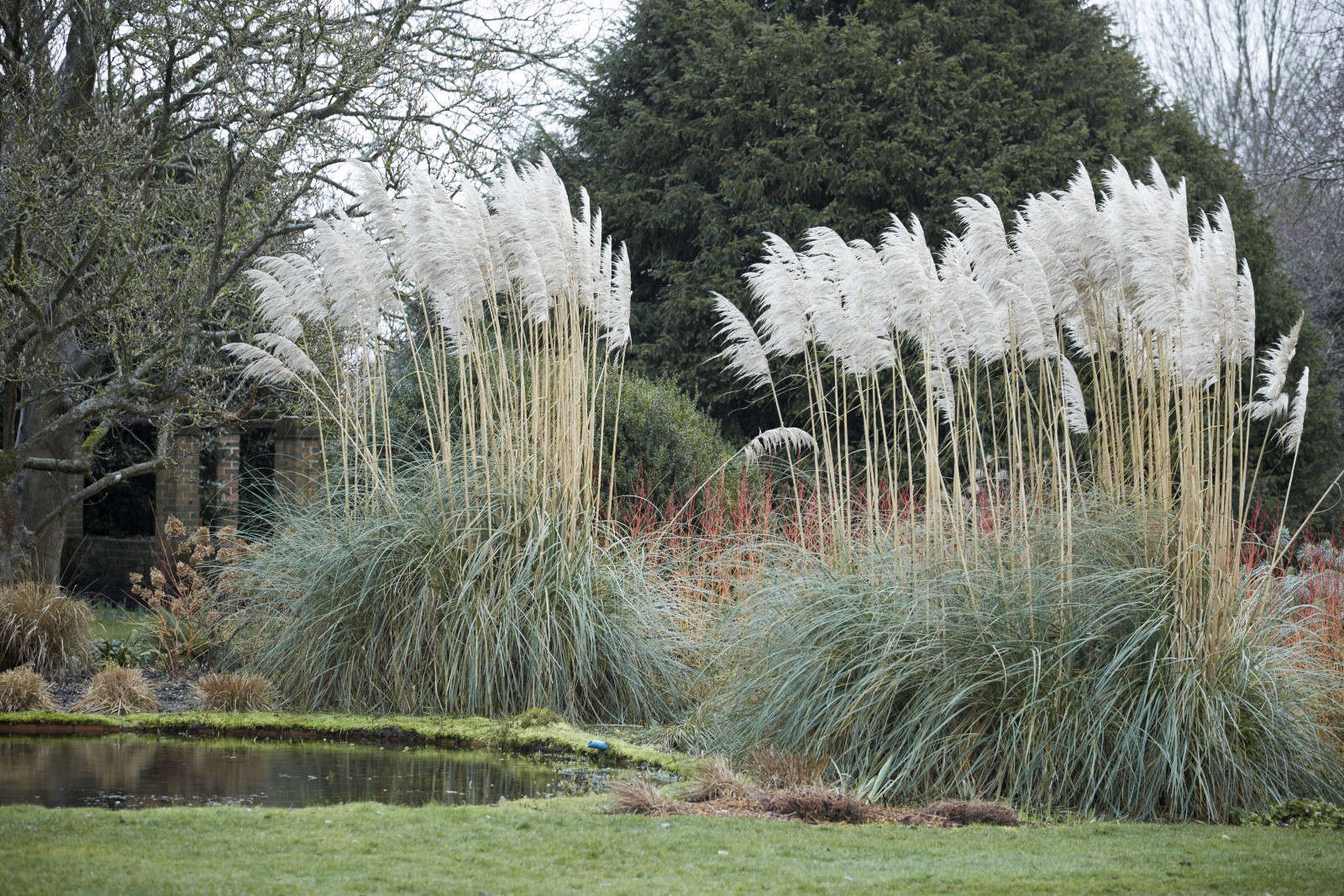introduction to pampas grass
Pampas grass (Cortaderia selloana) is an iconic ornamental grass known for its tall, feathery plumes and grand stature. Originating from South America, specifically the Pampas region of Argentina, it has become a popular addition to gardens and landscapes worldwide due to its hardy nature and striking visual appeal. But this plant is much more than just a decorative feature. There’s a depth of information regarding its growth, care, usage, and ecological impact. In this comprehensive guide, we’ll delve into everything you need to know about pampas grass, from its botanical characteristics to its practical applications and even controversies.
What is Pampas Grass?

Pampas grass, scientifically known as Cortaderia selloana, belongs to the Poaceae family. Its tall, majestic plumes, which can reach up to 10 feet in height, are what make this grass so iconic. The plant is characterized by sharp-edged leaves and voluminous, feathery flower heads that come in a variety of colors, from creamy white to blush pink.
This grass is native to the vast plains of South America, where it thrives in the windy and dry conditions of the Pampas region. Today, it’s found in gardens, public parks, and even along highways across the globe. While its aesthetic appeal is undeniable, pampas grass has become the subject of both admiration and concern due to its invasive tendencies in some regions.
Historical and Cultural Significance
Historically, pampas grass has been used by indigenous peoples in South America for various practical purposes. Its tall stalks were often employed in the construction of shelters and fences, while its fibrous leaves were used in weaving.
In more modern times, pampas grass has become a symbol of luxurious landscapes, especially in Mediterranean and subtropical climates. Its striking appearance is a favorite among landscape designers, who appreciate its low-maintenance nature and its ability to add height and texture to gardens.
However, pampas grass has also gained popularity in the world of interior décor. In recent years, its dried plumes have become a staple in bohemian and minimalist design aesthetics. Homeowners and decorators alike love the plant for its soft, natural look, which complements neutral palettes and adds a touch of organic elegance to any space.
The Growing Popularity of Pampas Grass
In recent years, pampas grass has seen a resurgence in popularity, thanks in part to social media platforms like Instagram and Pinterest. Images of homes and events adorned with the feathery plumes have gone viral, leading to a renewed interest in the plant. It’s now common to see pampas grass used in wedding décor, floral arrangements, and home styling. The plant’s ability to blend effortlessly into both rustic and modern settings has solidified its status as a go-to option for decorators looking to make a statement.
However, its newfound fame also brings with it a need for responsible growing practices. In some regions, pampas grass can become invasive if left unmanaged, and its unchecked spread poses a threat to local ecosystems.
Growing Pampas Grass: Tips and Tricks
Choosing the Right Location
The first step to growing healthy pampas grass is selecting the right location. As a plant that thrives in dry, sunny environments, it’s important to choose a spot that receives plenty of sunlight—ideally, at least 6 hours a day. Pampas grass also prefers well-drained soil, as waterlogged conditions can lead to root rot.
When selecting a site, be mindful of the plant’s size at maturity. Pampas grass can grow quite large, with some varieties reaching up to 10 feet in height and spreading several feet wide. For this reason, it’s a good idea to plant it in an area where it has plenty of room to grow, without crowding out other plants.
Planting and Soil Requirements
Pampas grass is quite hardy, which makes it relatively easy to grow, even for beginner gardeners. It’s typically planted from nursery-grown clumps or divisions rather than seeds, as seeds can be slow to germinate. Early spring or fall is the best time to plant, as the cooler temperatures allow the grass to establish roots before the heat of summer or the frost of winter.
While pampas grass can adapt to a wide range of soil types, it thrives best in sandy or loamy soil that is slightly acidic to neutral. Adding organic matter such as compost to the planting hole can help improve soil structure and provide the grass with essential nutrients.
Watering and Maintenance
One of the reasons pampas grass is so popular is that it’s low maintenance once established. It’s drought-tolerant and only requires moderate watering during its growing season. Overwatering can be detrimental to the plant, leading to root rot or fungal issues. It’s important to let the soil dry out between watering sessions, especially if you live in a region with high rainfall.
Maintenance is fairly straightforward, with the most significant task being the occasional pruning of dead leaves and flower heads. In late winter or early spring, before new growth begins, it’s a good idea to cut the plant back to about 12 inches above the ground. This encourages fresh growth and prevents the plant from becoming too unruly.
Fertilization and Nutrient Needs
While pampas grass doesn’t require heavy feeding, giving it a boost of fertilizer in the spring can help promote healthy growth and vibrant plumes. A balanced, slow-release fertilizer with equal parts nitrogen, phosphorus, and potassium is ideal. Avoid using high-nitrogen fertilizers, as these can encourage excessive leaf growth at the expense of flowers.
If you prefer a more natural approach, you can also mulch around the base of the plant with compost or well-rotted manure. This not only adds nutrients to the soil but also helps retain moisture and suppress weeds.
Popular Varieties of Pampas Grass
Classic Cortaderia Selloana
The most common variety of pampas grass is Cortaderia selloana, which is known for its large, white plumes and sharp-edged leaves. This is the species most often seen in landscaping and garden design due to its impressive height and striking appearance. The plumes of C. selloana typically appear in late summer and persist well into fall, making it a great choice for those looking to add interest to their garden during the cooler months.
Pink Pampas Grass (Cortaderia jubata)
For those looking for a more colorful option, pink pampas grass (Cortaderia jubata) is a beautiful alternative. This variety produces soft, blush-colored plumes that add a whimsical, romantic touch to gardens and landscapes. Like its white counterpart, pink pampas grass can grow quite tall, though it tends to be a bit less hardy and may require more care in colder climates.
Dwarf Pampas Grass
If you’re working with limited space or want a more manageable plant, dwarf pampas grass is a great option. This variety, Cortaderia selloana ‘Pumila’, grows to a more compact size, usually topping out at around 4-6 feet tall. Despite its smaller stature, it still produces the same striking plumes, making it a popular choice for smaller gardens or even container planting.
Silver Stripe Pampas Grass
Silver stripe pampas grass is a unique variety that features variegated leaves with a silver stripe running down the center. While its plumes aren’t as large or showy as those of other varieties, its striking foliage makes it a standout in any garden. This variety is particularly popular in ornamental gardens where foliage color and texture are emphasized.
The Invasive Nature of Pampas Grass: A Cautionary Tale
Why Pampas Grass is Considered Invasive
While pampas grass is a stunning addition to any garden, it’s important to understand that it has the potential to become invasive in certain regions. This is particularly true in areas with mild winters and plenty of sunlight, such as California, Australia, and New Zealand. In these environments, pampas grass can spread aggressively, outcompeting native plants and disrupting local ecosystems.
One of the reasons pampas grass is so invasive is its ability to produce a large number of seeds, which are easily dispersed by the wind. These seeds can germinate in a variety of conditions, making it difficult to control the plant’s spread once it becomes established.
Ecological Impact of Invasive Pampas Grass
When invades an ecosystem, it can cause significant damage to local biodiversity. Its large size allows it to overshadow native plants, reducing their access to sunlight and nutrients. In some cases, can even alter soil composition, making it less hospitable for other species.
In areas where it has become invasive, can also increase the risk of wildfires. The plant’s dry leaves and flower heads are highly flammable, and its dense growth can create a fire hazard, especially in regions prone to drought.
Responsible Growing Practices
If you live in a region where is considered invasive, it’s essential to take steps to prevent its spread. One way to do this is by regularly pruning the flower heads before they set seed. This not only helps control the plant’s growth but also reduces the likelihood of it spreading to neighboring areas.
Alternatively, you can opt for sterile varieties of , which are bred to produce little to no viable seed. These varieties are less likely to become invasive and still offer the same visual appeal.
Pampas Grass in Landscaping and Design
Adding Height and Drama to Your Garden
One of the most striking features of is its height, which makes it an excellent choice for adding vertical interest to your garden. The tall, plume-topped stems create a dramatic focal point, especially when planted as a standalone specimen or in groups.




